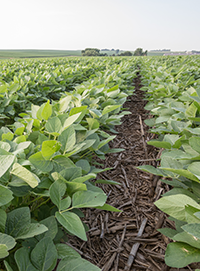 3 Key Takeaways From This Article:
3 Key Takeaways From This Article:
- Scout your customers fields for weeds, diseases and insects in late summer.
- Take a lot of notes and photos of what you find in the fields.
- Use that data to help create customized crop protection programs for your customers in the future.
The dog days of summer are upon us. At this time of the season, the bulk of crop protection applications are complete and harvest is only a few months away. Use this opportunity to do some late-season scouting in your customers’ soybean fields.
In August and early September, look for weed escapes, disease symptoms and insect-feeding damage. Even if it’s past the application window for certain solutions, you can use the information you gather to improve your growers’ future plans.
Weeds
Walk your customers’ fields and look for any weeds that were left uncontrolled by herbicides. It’s likely too late to apply any more herbicides, but you may want to pull some of the weeds you find by hand.
One waterhemp plant can produce more than 200,000 seeds, and many other troublesome weeds like lambsquarters and giant ragweed can produce tens of thousands of seeds. By hand-pulling them, you’ll prevent thousands of seeds from entering the weed seedbank. Those seeds can sometimes survive in the soil for decades, so removing the plants can help with future control.
Another important thing to consider with weed escapes is resistance. Are the weeds present herbicide resistant, or did something go wrong with the program approach you used?
If you suspect resistance, you can and should send samples of the weeds in question to a diagnostic lab. If something went wrong with your program, for example, maybe bad weather forced you skip a postemergence application, you can take note of that now and make a different plan for next year.
Don’t forget: A program approach using preemergence herbicides such as Sonic® herbicide or Trivence® herbicide, both with multiple modes and sites of action, is critical to effective early-season weed control. Additionally, fall burndown applications can help with winter weed control and keep fields cleaner for the next spring. You can help your customers build a customized program by reviewing soybean herbicides options from Corteva Agriscience.
Diseases
While you’re in soybean fields, keep your eyes peeled for evidence of disease. When scouting, I recommend looking for symptoms on the lower leaves and stems, working your way up the plant.
One disease I’d like to call out is sudden death syndrome (SDS), which usually shows up in late summer. The symptoms start as yellow spots on leaves that transition to yellow patches, which eventually turn into brown dead tissue. You also can check the roots for bluish spore masses.
Once SDS shows up in a field, it generally spreads to larger areas in future seasons, which can hurt yield. Foliar fungicides are not effective in controlling it. However, if you find SDS, you can help your customer choose resistant varieties or seed treatments that include a fungicide.
Other diseases like white mold can show up in late summer as well. These can take a bite out of yield if left to flourish. A foliar fungicide like Aproach® Prima can control many such diseases and you can apply it curatively. However, if you did not apply a fungicide preventively this year and you find symptoms, I would take that as a sign to do preventive spraying next year.
Insects
Finally, scout for insects and feeding damage on your growers’ soybeans. Look at leaves, pods and stems for signs that pests have invaded. Some insects, like stinkbugs, puncture plants very discreetly, so it’s hard to see the damage they’re doing from the outside. That’s why it’s important to take note of the actual pests you see when you’re in the fields.
If your customer has soybeans that were planted at different times, pay closer attention to the later-planted beans as senescence begins. Insects tend to avoid the browning plants in favor of the ones that are still green. If loopers or worms are present, consider treating with Intrepid Edge® insecticide.
Help your farmers control pests you find by applying an insecticide, but be aware of preharvest restrictions. Depending on the product, you’ll need to wait about a month before harvesting the soybeans after spraying Intrepid Edge® insecticide from can control worms and loopers, with a 28-day preharvest interval.
Save the Data
As you scout, make sure to keep good notes and take photos of any issues you find. Save this data and be sure to go over it with your customers as you start planning for next year.
Use your findings to see what improvements you can make. If you have weed escapes, maybe you can strengthen the weed control program. If you find disease, you can recommend resistant soybean varieties and spray a fungicide preventively. If insects are a problem, make sure to have an insecticide ready for next season. Maybe there are even equipment upgrades to be made or drainage issues to be fixed before spring 2021.
By saving the data you collect year over year, you will build field history data, allowing you to better predict problem weeds, diseases and insects where they historically occur. The more field-specific data you possess, the greater the opportunity to customize the best solutions for optimal yield.
About the author: Joe Armstrong is the biology leader for row crops herbicides for Corteva Agriscience. Armstrong has a Ph.D. in weed science from Michigan State University. He received his master’s degree from Purdue University and his bachelor’s degree from Kansas State University.
™ ® Aproach Prima, Sonic, Trivence and Intrepid Edge are not registered for sale or use in all states. Contact your state pesticide regulatory agency to determine if a product is registered for sale or use in your state. Always read and follow label directions.